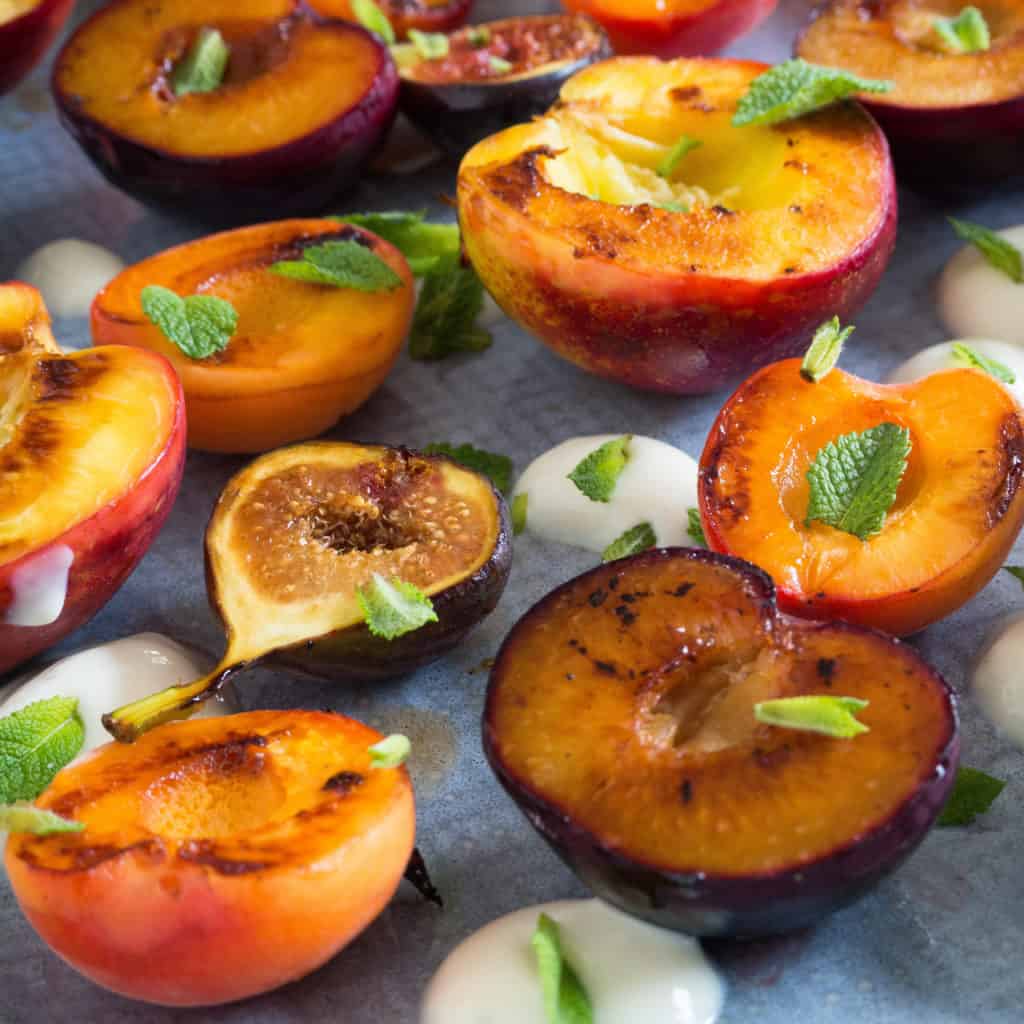
The beauty of Grilled Summer Fruits is that you can use whatever is in-season, available, free from friends trees. You start with succulent, ripe fruit and make it even better than it is raw. I love this recipe because I sometimes struggle with fruit. It does not always agree with me but cooking it – even a little seems to make it more ‘digestible’. I adore the simplicity of this recipe and keep it really simple by serving with mint and non-dairy yoghurt.
Grilled Summer Fruits are super easy and super quick.
You can find the full Grilled Summer Fruits recipe here.
The versatility of Grilled Summer Fruits is one of the things I like. You can serve Grilled Summer Fruits as a starter, as a salad with rocket or spinach or as a pudding with non-dairy yoghurt or ice-cream.
You can use any available, firm, in-season fruit. Grilling works especially well with nectarines, apricots, figs and plums but you can also grill peaches, apples, apricots, mango, plantain, pineapple (not at all seasonal in the UK but great grilled).
Use fruit that is still firm, when it is grilled it will become much softer. If you use a very ripe fruit it may well disintegrate on cooking.
You can use a large frying pan, grill pan or outdoor barbecue to grill fruit. You can also grill them under a ‘normal’ grill.
h1>Preparation
Difficulty easy
Preparation time 5 minutes
Cooking time 20 minutes
You can find the full Grilled Summer Fruits recipe here.
h1>Allergens
Grilled Summer Fruits are gluten-free and vegan as well as…
Celery free
Coconut free
Garlic free
Lupin free
Mustard free
Nightshade free
Onion free
Peanut free
Sesame free
Soya free
Tree nut free
h1>About
Figs are wonderful and grow really well in some parts of the UK. The most impressive fig tree, producing the most fruit and the most delicious fruit I have ever seen was in my brother’s garden in Bristol. Fig tree or fig (ficus) is a genus of about 850 species of woody trees, shrubs, vines, epiphytes and hemiepiphytes in the family moraceae. Figs are native throughout the tropics with a few species extending into the semi-warm temperate zone. The common fig (figus carica) is a temperate species native to southwest Asia and the Mediterranean region (from Afghanistan to Portugal), which has been widely cultivated since ancient times for its fruit. The fruit of most other species are also edible though they are usually of only local economic importance or eaten as bushfood. However, figs are an extremely important food resources for wildlife.
Interestingly there is usually only one species of wasp capable of fertilising the flowers of each species of fig and therefore planting fig species outside of their native range results in effectively sterile individuals. For example, in Hawaii, some 60 species of figs were introduced, but only four of the wasps that fertilise them have been introduced therefore, only four species of figs produce viable seeds there and can become invasive species. The intimate association between fig species and their wasp pollinators, along with the high incidence of a one-to-one plant-pollinator ratio have long led scientists to believe that figs and wasps are a clear example of coevolution.
A 100 gram serving of raw figs provides 74 kilo-calories. Raw figs supply no essential nutrients in significant content (all < 10% RDA). However 100 grams of dried figs supply 249 kilo-calories with the dietary mineral, 24% RDA manganese and vitamin K in moderate amounts of the RDA. Figs are used in both sweet and savoury cooking and baking across the world. Fresh figs straight from the tree are a wonderful thing. They are best lightly cooked (if at all) and used warm in salads or desserts.